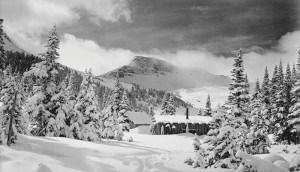
Spring is here, in all its Rocky Mountain glory. As the days become longer, we find ourselves turning our faces to the warmth of the sun, and for many of us, weÔÇÖre still propelling our skis up into the high mountain passes.
This story concludes my four-part series, which has been depicting backcountry ski history in JNP. IÔÇÖve touched on a rescue in the Trapper Creek area in the 1930s, given Agnes Harragin (one of the first female horse guides in the national parks) some long overdue recognition by informally naming a prominent creek after her, and I've shined some sun on some of the hot female skiers of the 1930s and 40s.
These stories have been really fun to write, and I've learned a lot along the way. Unfortunately, what has been very prevalent, and has shook this skiers knees to a knockinÔÇÖ, is the worrisome realization of how doomed backcountry skiing is in JNP. Not only are there caribou closures, but there is also the rapid growth of trees in all alpine regions. The warmer climate has fertilized and expedited the incessant march of these trees into all mountain passes. In all my mountain forays this winter, I looked around and thought, ÔÇťIn a few decades there will be no alpine, no alpine passes, just a forest of trees to fight through.ÔÇŁ
How do we as skiers schuss with any optimism into the future of backcountry skiing in JNP? I pulled some collected ideas out of the old, metal, sticker-infested wax box in the basement. To be able to win against the army of fast growing trees, decisions have to be made soon.
Popular accesses to the high passes have to be ÔÇťski smartedÔÇŁ, a form of fire smart. Descents and perennial up tracks through bush-grabbing hell have to be cut back and opened up. Some of the warden cabins situated out of caribou habitat could be ÔÇťrepurposedÔÇŁ for some new ski hut opportunities, and the skier wall tents/camps could once again be allowed. ItÔÇÖs those tents that are the subject of my next story.
Part four: The ski tents of the glory years
What if someone asked you, ÔÇťhey do you want to go ski touring?ÔÇŁ
Of course, youÔÇÖd say, ÔÇťsure, where, how many days?ÔÇŁ
ÔÇťSix-day trip, weÔÇÖll stay at the Watchtower ski camp, shred the basin, then head up and over the col, do some super G turns down Big Shovel Pass, hang out at Shangrila for a couple of nights, tickle AberhartÔÇÖs nose, then head over Little Shovel Pass, down Agnes Creek and then head up the long length of Trapper Creek to the ski tents up there.ÔÇŁ
ÔÇťToo crazy,ÔÇŁ you might think. Still, your jaw would drop, and a tiny trickle of skier drool would escape the side of your mouth. If this conversation happened anytime in the 30s, 40s or 50s, youÔÇÖd be packing your bag, and readying your ski gear.
Not only were there ski tent cabins at the headwaters of Trapper Creek, but there was also a collective colony of tents up in the Watchtower (near the existing campground) as well. A small cabin was constructed in 1939, thanks to the ski haggling of the Maligne Ski Club, which recently had huge success with the Shangrila cabin, and wanted to add more to the ski hut roster.
The Watchtower Basin is an incredibly sublime and ski flawless basin, and was well suited to the fast growing bunch of keeners that wanted to slurp┬á up some of the Maligne ValleyÔÇÖs already legendary powder.
There was also a convenient cabin, operated by Fred Brewster up near Curator Lake on the Skyline Trail. The fit and the diehards often used this cabin to ski Big Shovel Pass and up to the Notch, the crux, the nemesis of the Skyline Trail summer or winter.
Doris Kensit (one of the hot female skiers) recalled, ÔÇťGoing over Shovel Pass was a strenuous trek. On one trip we couldnÔÇÖt get over the Notch, due to a huge snow cornice, so we camped at Curator, and went down the trail to Wabasso Lake. We ran out of snow, and had to lug those heavy skis all the way back to town.ÔÇŁ
Then there was Joe Weiss, a name synonymous with all early ski development in JNP. Chic Scott, a renowned skier and author of guide books wrote about Joe, ÔÇťBetween 1929-1933, Joe Weiss made five ski expeditions into the heart of the Rockies, including two traverses all the way from Jasper to Banff.ÔÇŁ From the 30s, and on, Joe was dreaming and scheming and doing some serious ski hut recce.
His plan was to build huts along the modern named Six Pass Route, which starts at Maligne Lake and follows high mountain passes up and over valleys to finally spit the skiers out 50 km south at Sunwapta Warden Station/Poboktan. Sadly, this never materialized; there are only scribbles on blurred photographs citing the merits of the ideal cabin locations.
This skier stares out over the Maligne range, slightly stunned at the magnitude of what never happened, and the skiing history that is now lost. Is there any hope, I wonder? Is there any chance at all of making some new backcountry ski history in JNP?
Something catches the corner of my eye, a man, whoÔÇÖs been shadowing my turns; heÔÇÖs wearing wool knickers and is carving arcs with long wooden skis, a fine spray of heavenÔÇÖs meringue off each perfect turn. What does this man know as he yodels with delight in the fresh snow?
He stops, and beckons me over with a wave, my spirits lift as I ski over, and we simultaneously lift our feet, to catch some air off a snowy knoll, our long shadows stretch out, to become permanently suspended in time.
Loni Klettl
Special to the 51░Á═°
